The cave is located in Porto Badisco, about 10 km south of the municipality of Otranto, in the province of Lecce; the main entrance is located about 28-30 meters above sea level, on the promontory of the inlet of Porto Badisco, and its maximum depth is about 26 meters below sea level, for a total extension of the galleries of about 1500 meters all around inside the white karst surface.
On the walls of the cave are depicted numerous paintings, almost 3000 pictograms, from the smallest of about 2 cm to the largest of about 75 cm, concentrated in groups in about 60 panels on both walls of three galleries, for a total of 600 meters path and about 1200 meters of drawings. The pigments and adhesives used are organic and mineral materials found on site, mostly black painted, mainly made with subfossil bat guano, and a smaller number of red, made with red ferruginous ochre, obtained with a of animal fats and mineral colors.
In a recent study, the palethnologist Maria Laura Leone proposed a reading of the wall paintings of the Grotta dei Cervi, exhibited in her book "La phosfenica Grotta dei Cervi" (Edizioni Pensiero Preistorico 2009), from which the drafting of this profile takes its cue.
The paintings in the cave include few realistic elements (the scene of a deer hunter assisted by two dogs recurs, the motif that gave the name to the cave, humanoid and theriomorphic beings similar to ghosts, female figures, ghosts and bizarre sprites, dance scenes tribal or propitiatory rites) and many essentially abstract (concentric circles, spirals, crosses, stars, parallel lines, regular chessboards, grids, elaborate forms of double spirals, meanders, single and specular "S" shapes, labyrinths, snakes, chains, zigzag, pectiniform). The cave develops in a north-south direction on 3 tortuous natural corridors and some large rooms, only partially accessible.
The first corridor, accessible directly from the main entrance to the west, is the most tortuous one, with sudden lowering of the vault; about 50 meters from the entrance there is a pool for collecting water and at the end zone I, named by the author Dromos, where the first paintings and the entrance to the fourth corridor without drawings are found.
Continuing towards a narrow passage, you enter the second corridor, the richest in pictorial representations and the easiest to walk through. Its first environment, a room 4 meters high, is zone III named by the author Salone Rosso for the ocher paintings (the one of the Fish Woman with two fins instead of feet should be noted); then zone IV, named by the author the Androgen room, due to the presence of a large natural anthropomorphic figure, about 2 meters high, surrounded by thread-like beings in different positions. Continuing on, we find zone V, with two adjoining rooms, the circular Sala delle Lizards suitable for holding meetings, with a lizard or gecko painted at the entrance and further on, the Sala delle Ceremonie with six marathon runners running. Beyond that, zone VI, rich in stalactites and stalagmites, and the Vestibule, called zone VII, a kind of antechamber where there was the ancient deposit of guano. This environment precedes the Sanctuary, zone VIII, so called by the author due to the presence on the ceiling of small handprints which, due to their small size, suggest female or child hands in the ritual gesture of the transition from childhood to adult. In this environment the most controversial figure of the site is painted, a female figure with breasts attached directly to the neck, a triangular head surmounted by a crown with seven rays, with an S-shaped body, called by the author the Lady of the Serpents due to the presence of two specular S-shaped attributes under the legs. Maria Gimbutas, in her book "The language of the Goddess" (Le Civette di Venexia 2008) indicated that "these figures with snake-like limbs..." were to be referred to the Neolithic Mother Goddess Serpent, symbol of cyclical time. The last room of the second corridor is the tabernacle, zone IX, a small circular room, where the ceiling drops considerably and where seven pictorial groups are depicted with a few scattered graphemes; there is also a cup to collect liquids probably used as an altar for ablutions and rituals. In this room a collapse occurred which closed the gallery even before the visitors of the cave could explore the following rooms.
From the Salone Rosso there is access to the third corridor, composed in sequence of zone X called the Salone degli Arabeschi with labyrinthine paintings and stalactites, zone XI called the Sala delle Spirali and zone XII the Sala Recondita with the latest paintings. Subsequently, the vault drops considerably and the cave is no longer accessible.
The three branching tunnels of Porto Badisco with their hundreds of painted figures and signs are up to now the largest post-Paleolithic complex of wall art in Europe; due to the importance of the finds, it must have certainly been a sanctuary or a place of worship.
The caves were perceived as a metaphorical womb of the Mother Goddess, revered by agricultural communities, whose symbol, the spiral, represented life and regeneration.
In the aforementioned study, palethnologist Maria Laura Leone proposed a parallelism between the art of the Grotta dei Deer and that of other cultures, in particular of the Tukano (indigenous people of Colombia) and the art of Chumash (Indian cult of Antap, shamanic ritual ), who used the same Badischian symbols as an expression of a religiosity in abstract forms; the authors of these paintings were individuals gifted with particular investitures, shaman artists, who in the grip of modified states of consciousness, perhaps due to the assumption of hallucinogenic substances or a blow to the head or more simply due to particular pressure on the eyeballs, represented what that they saw with their own eyes, the phosphenes, i.e. regular and bizarre geometric shapes that are seen in certain neurological situations. By virtue of this principle, the hunting scene becomes readable no longer as a normal hunting act, but as the evocation of a myth or a shamanic rite practiced in an ideal context to arouse visions, a gateway to otherworldly worlds. The ecstatic journey was practiced in sacred places that were difficult to access to most people and the Grotta dei Cervi, with its caves that were difficult to access, was the place chosen for immersion in the elsewhere, the place in which to carry out propitiatory or initiatory religious rituals. In the cave, in addition to the paintings, a remarkable set of ceramics was found, especially in the front part of the cave, where daily life probably took place (discovery of various pottery, bowls, vases and bowls), while other ceramics were found within the natural cavities of the rock and in the vicinity of the paintings, as if they were used to carry out particular rites.
Of particular importance is the lid of a ritual vase decorated with a double W, which has the face of the Mother goddess on the mouth and which dates back to the XNUMXth millennium BC
Also important are the pintadere, sort of terracotta stamps for painting the body during the initiation and ritual ceremonies that were to take place inside the cave; one of the two specimens found has a spiral figure, the dominant graphic module in the pictograms of Porto Badisco. As regards the reconstruction of the human habitation of the ante-grotto, apart from the superficial discovery of burnt grain and abundant ceramic fragments with red bands typical of the faces “Serra d'Alto”, some skeletons were also found along the corridors.
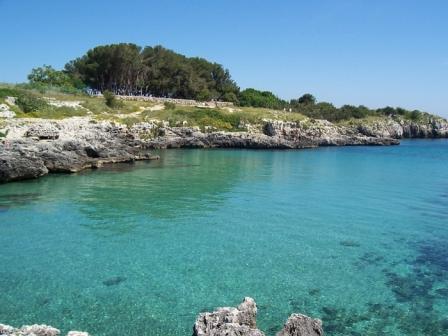

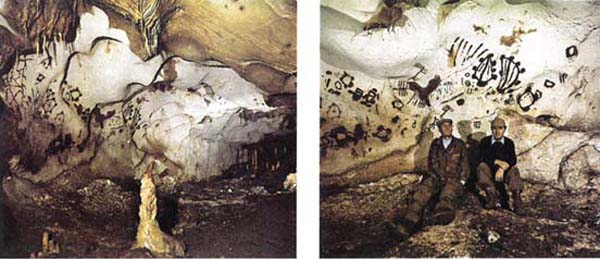
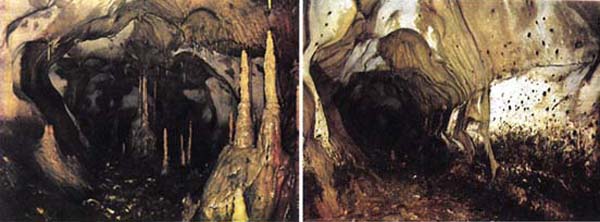
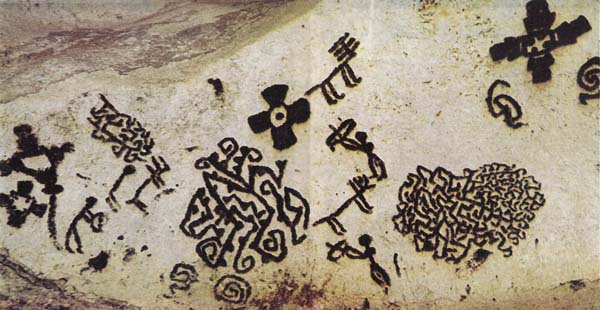
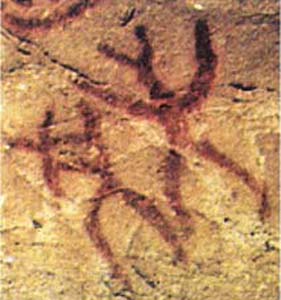
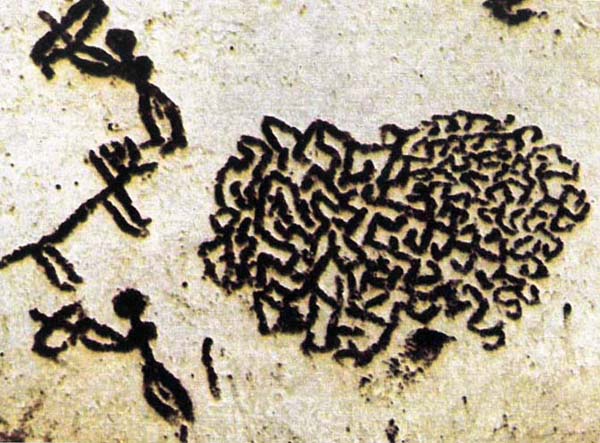
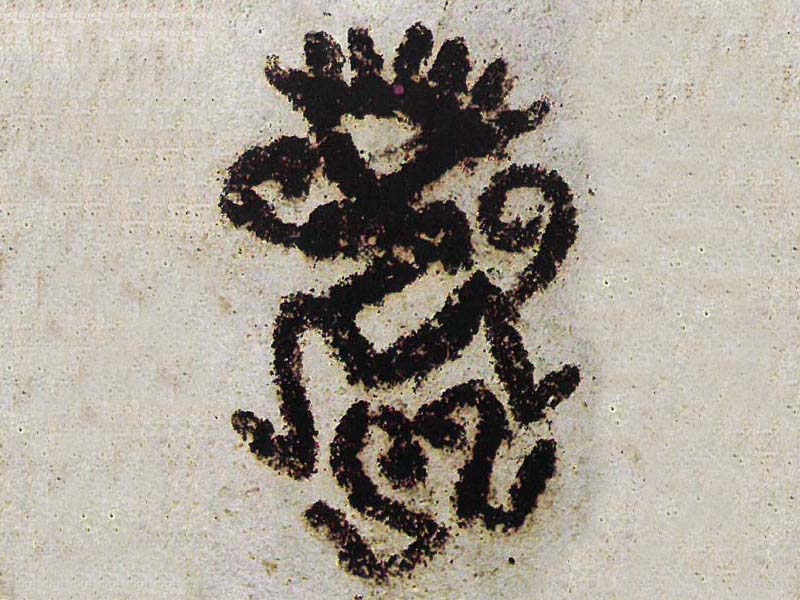
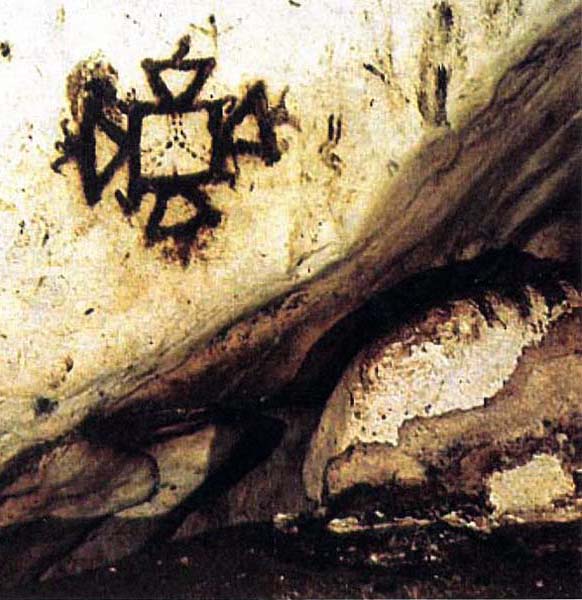


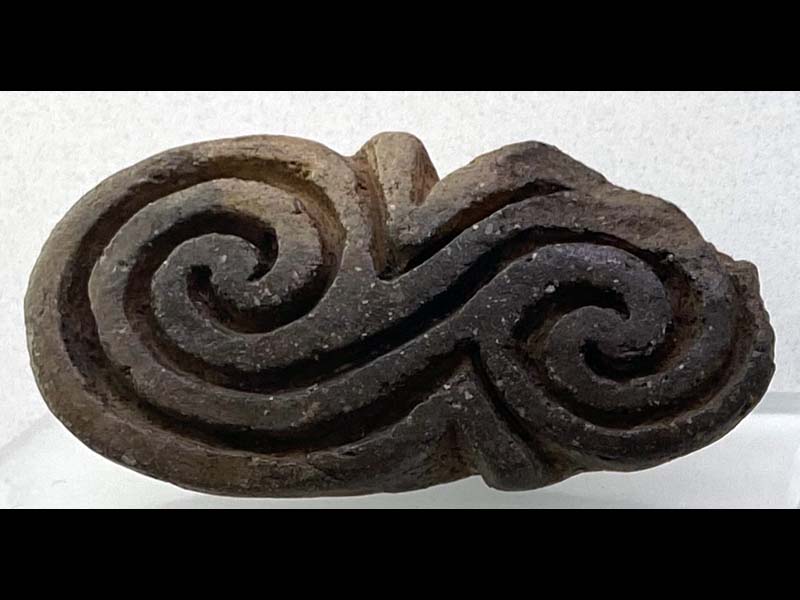
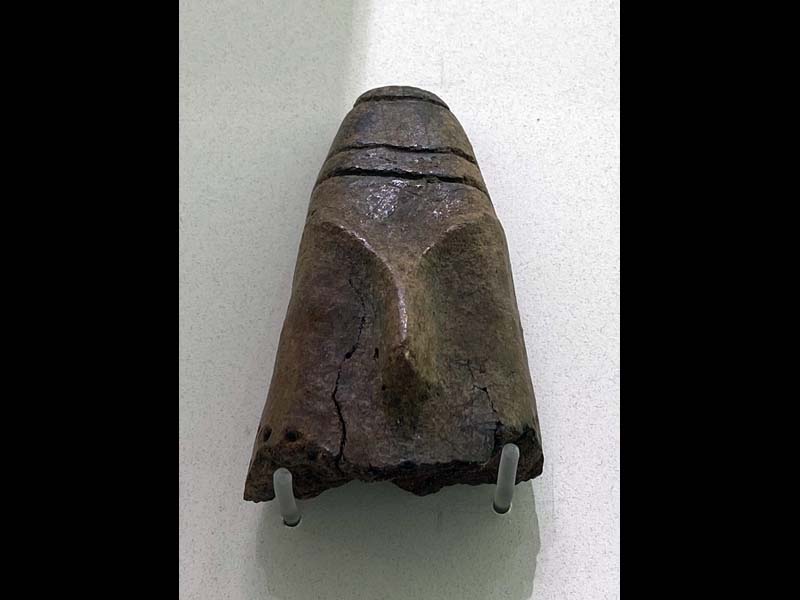
Historical notes
The discovery of the cave is linked to an anecdote. On 1 February 1970 some speleologists of the "Gruppo speleologico salentino de Lorentiis" of Maglie (Severino Albertini, Enzo Evangelisti, Isidoro Mattioli, Remo Mazzotta and Daniele Rizzo) were making an excursion in the inlet of Porto Badisco, where an ancient legend narrates that the landing of Aeneas had taken place (from a study conducted by archaeologists from the University of Lecce, it seems that the precise place is in nearby Castro, in a place called Castrum Minervae, where there is a temple dedicated to the goddess mentioned by Virgil) .
One of them noticed a strange fresh air coming from a hole in the rock and after having moved the surface material he brought to light the first representations of cervids along the walls of the cave. They baptized it "Grotta di Enea", from the nickname of the Port, but soon they named it "Grotta dei Cervi" due to the frequent presence of deer hunting scenes. From that moment on, the studies and surveys were entrusted to the director and founder of the Italian Institute of Prehistory and Protohistory in Florence, Paolo Graziosi, who studied the site until 1988, the year of his death. The site has been used as a shelter since the Paleolithic, but the greatest attendances date back to the Neolithic, as a place of worship in which to perform religious rituals; the object of devotion was Mother Earth, responsible for the fertility of the soil and the richness of the crops. Undoubtedly the paintings of the Grotta dei Cervi, as a whole, are characterized by a schematic nature that recalls the Neolithic forms, but among them there are also forms that derive from a Paleolithic stylistic tradition, similar to the more famous frescoes in the realistic style of the Franconian caves. Cantabrian villages of Altamira, Font-de Gaume, Lascaux, Niaux, Peche Merle, etc.
CARD
LATEST PUBLISHED TEXTS
VISIT THE FACTSHEETS BY OBJECT

